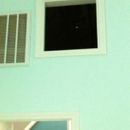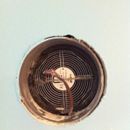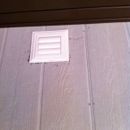Blower door disappointment and questions
We had our final blower door test and it wasn’t what we had hoped. Our initial cfm50 was 98 with windows and door and all the sheathing done so I expected a substantially better result with insulation and the smart vapor barrier. Our result was 220.
Obviously the higher air leakage has to be from penetrations after the building envelope was finished – vents mostly, I figure.
My questions are – do you tape over the vent covers or the HRV vents for the blower door test? Also, when you calculate volume do you include everything within the thermal envelope? The ceiling joists are insulated with dense packed cellulose. In the 2 upstairs bedrooms, the ceiling is 8 ft, but the storage area above that is not really closed off from the house. Is that considered part of the house volume?
Thank you for your help. I realize that 220 is still a “Pretty Good” result, it’s just that I hoped for better.
GBA Detail Library
A collection of one thousand construction details organized by climate and house part












Replies
If the person using the blower door can't explain your test I hope you didn't pay for it.
Who ever did the air sealing should be working with a good blower door person and be able to find leaks and understand leaks and what to do about them.
How is someone on the internet supposed to be transported to this build and be able to know what was done for the planning and building and testing of your home for the last several years?
Seriously? Yes, seriously I ask.
aj
You're discovering part of the problem with chasing single numbers and endowing them with magical powers. Relax. More important to make sure the details were done right. Did you have a smoke pen? Find any spots that made you nervous?
Hi Lucy,
....Congratulations on your EXCELLENT air tightness results...
You may find some clarification about sealing vents in comments #49 thru #60 from this blog.....
https://www.greenbuildingadvisor.com/blogs/dept/musings/questions-and-answers-about-air-barriers.
I like Dan's statement "the problem with chasing single numbers and endowing them with magical powers." I was frustrated with the test because I worked so hard to seal every hole in the envelope. I even coated the nails that penetrated the sheathing with the prosoco joint and seam sealer. The sheathing was taped completely on the exterior, then either taped or sealed inside. Every stud bay was sealed individually. Then we used very well-taped Intello Plus as the smart membrane to hold the dense pack cellulose. It was also sealed to the floor.
The subfloor was taped. Insulation under the subfloor is covered with a membrane (not completely taped at this time. I needed a break from crawling around under the house. The weather is beginning to get nicer so I will resume my obsession with taping under the house soon.)
What I could not control as well were the vents, vent pipes, vent covers. I don't think the vent pipes are taped to the sheathing. I think that was installed later. I don't understand how you seal around them. What is supposed to be removable? Do you always leave the vent cover so you can remove it to clean out vents? Does that mean you can't caulk around it with the flexible caulk?
John, thanks for the information on the closing the vents on the HRV. We did close the downstairs ones, but not the upstairs ones. I didn't know if I was "cheating" on the test or not. Thank you for commenting.
AJ asked about what the blower door person said. Truthfully, I did not ask him. He was late for the test and had to rush off for another test so we did not try to find leaks. I guess I should have insisted. The main problem is that I am not a builder and there is so much I don't know and didn't know during the construction process especially around the vents. In general, I do know more about air sealing than anyone else involved in the project, but I was not on site everyday (have to work though it is in an ER so I do have days off during the week) and I missed opportunities with the venting.
Thank you for your responses.
Lucy, if I had tested your house I would have sealed off the HRV inlets and outlets. For code compliance here in WA, that is the protocol.
I don't understand exactly how the storage space you describe is configured, but it sounds like part of the indoors and I would include the volume of it in my ACH50. In general, for determining volume, your boundaries are the subfloor, the drywall ceiling, and then you decide between the drywall walls vs. the sheathing. The difference in that last factor is slight, but you make an assessment as to where the air barrier is. It sounds like yours is the sheathing.
Since you have CFM50, do your own volume calc and determine ACH50. I agree with Dan that the most important thing is to determine if what you tried to do worked. On projects like yours, a test without any leak-finding is less than ideal.
Every pipe, conduit, duct, wire that penetrates your air barrier can be booted or caulked. There is fire caulk and metal flashing for where a 2" fire code obviates rubber boots.
Where to find boots and how to make your own, one source is plumbing, another is commercial roofing. Flat roofs have a multitude of penetrations that are water tight sealed which is the same as your needs.
And yes when you blower door test, one should also spend time seeing where the air is penetrating.
Lucy, your home sounds like it is super over built well, congrats. You can do your own blower door testing with a homemade blower door. All you need is a fan and an imagination.
The real test is how much energy your home uses. I bet very little. I have a three family members in the ER or transporting to it, very proud of all of you for your chosen occupations.
AJ's point is right on - we don't own a blower door, but we have both an asbestos abatement air scrubber (a big box with a HEPA filter and a 2000 cfm fan) and a couple of very powerful fans we salvaged from a job and mounted to a piece of plywood. Both are more powerful than the fan on a blower door, so are better for finding leaks. It's not hard to rig something up yourself. Rent a big fan, buy some smoke pens, and go to town.
Dan and AJ,
I have a huge fan that we used earlier in construction when it was very hot. I can mount it on some scrap plywood. That's a great idea. It also might come in handy when we're finishing the floors and need to move some air through the house.
David,
Thank you for your information on closing the HRV ducts. I chose the Lunos e2 HRV because the mechanical room was so tiny, nothing else would fit in there. Design flaw, I know, always make the mechanical room bigger than you think you might need. I am very happy with the Lunos fans, but we put the two upstairs ones in a very difficult-to-reach location so it was impossible at the time of the test to close them off. Another design flaw (my fault) because it will be so difficult to clean the filters.
Thank you again. I cannot tell you how helpful you have been during the construction of this home. Just working in the home, you can feel the difference because it is so quiet and comfortable and holds heat or cool air so much better than any home I've ever been in. The electric bill this June ran about $63 with constant AC at 72 degrees, constant dehumidifier running, leaving doors open for workers going in and out, machinery, etc. The tiny trailer we tore down to build the house cost over $200/month to keep the summertime temps close to 80 degrees. A delightful difference. Move in date is the first week of September.